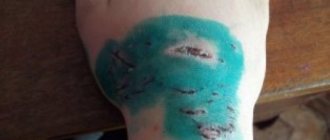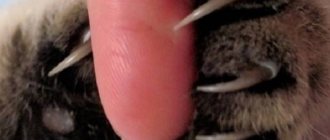Domestic cats bring owners a lot of positive emotions. However, there are also disappointments, for example, if the pet bites or scratches. In some cases, this entails not only a spoiled mood, but also a threat to health.
- 2 First aid
- 3 When do you need a doctor?
3.1 Video: doctor about pet bites
- 4.1 Drug therapy
- 5.1 Video: in the Kama region, a teenager died after being bitten by a cat
- 6.1 Video: how to pet a cat to avoid scratches
Why are cat bites and scratches dangerous?
Often bites and scratches from pets go away without serious consequences. But unfortunately, it happens differently. Any injuries to the skin can lead to serious health consequences, such as:
- suppuration;
- blood poisoning;
- deadly diseases such as tetanus.
Bites and scratches are familiar to all cat owners.
There are symptoms to look out for if you have recently been scratched or bitten by a cat:
- temperature;
- swelling of the hand or other injured area;
- bleeding from the wound does not stop;
- the wound hurts a lot;
- the bite site or scratch began to fester.
If such manifestations occur, you should immediately seek medical help.
Often people delay going to the doctor, hoping that the symptoms will disappear on their own. But you can’t hesitate, since spontaneous recovery is extremely rare, and usually without medical help a person only gets worse.
How do you determine if a cat has rabies?
Tests to determine the virus are taken after the death of the cat to make an accurate diagnosis. The causative agent of rabies is detected in brain tissue.
This method allows you to reliably determine the presence of rabies. The virus can be diagnosed in saliva and cerebrospinal fluid, but a negative test does not guarantee the absence of disease.
Animals are rarely diagnosed. Diagnosis is made by symptoms. A sick cat is isolated for up to a month. If infected, the animal dies.
First aid
In any case, if a cat bites or scratches, you need to immediately treat the wound. This will reduce the risk of complications.
- Wash the area of the bite or scratch with soap and water, preferably household soap. It will sting, but the cat’s saliva and possible bacteria will be washed away.
- Treat the wound with 3% hydrogen peroxide or 0.05% chlorhexidine solution.
- Disinfect the edges of the wound with iodine, brilliant green or alcohol. Try not to get into the wound itself, otherwise a burn may occur.
- Apply a gauze bandage to the treated area.
After some time, when the bleeding has completely stopped and the wound has dried, you can apply a bandage with antibacterial ointment. This will allow healing to occur faster and reduce the risk of re-injury to the wound. The following are considered effective:
- Miramistin. Prevents inflammation and wound suppuration.
- Rescuer. The balm relieves pain and accelerates scarring of the wound.
- Solcoseryl. It heals scratches well and prevents the formation of scars, but it can only be applied to a dried wound. If there are signs of inflammation and suppuration, do not use.
- Levomekol. Typically used when pus forms. If the injury occurred far from the city, where there is no opportunity to get medical help, and suppuration has begun, you can use this ointment.
Important! All medications must be used strictly according to the instructions, taking into account age, contraindications and other points. Find out also - How to rid a kitten of the habit of biting and scratching its owners.
When do you need a doctor?
As already mentioned, in some cases you will have to consult a doctor. The already mentioned symptoms will be a signal to seek medical help:
- swelling at the site of the bite or scratch;
- swelling of the hand or other bitten limb;
- bleeding that does not stop or renews;
- elevated temperature;
- numbness of the injured area;
- wound suppuration;
- loss of consciousness.
In general, temperature can be a signal from the body to fight bacteria. However, if it is accompanied by swelling, this is always a bad sign. A tumor is a signal that the body cannot cope with an infection (and this could be, for example, dangerous tetanus or pasteurellosis), and it requires help, the type of which only a physician can determine. You cannot self-medicate.
A hand swollen after a cat bite is an alarming symptom
In addition, you cannot avoid going to the doctor if the mobility of the bitten limb is difficult. It is extremely rare, but there are cases when an animal damages tendons with its teeth. In this case, only a surgeon can help.
To get urgent help after a cat bite, if it is impossible to get a number to the local surgeon or it is night outside, you should contact the trauma center.
Even when there are no negative symptoms, you should go to the doctor if the cat that bit or scratched was a stray. In this case, you need to seek help immediately after carrying out primary medical measures. Street animals are always a breeding ground for all kinds of infections, so you will need a rabies vaccination and, possibly, other medical measures at the discretion of the doctor. In principle, pets can also get rabies if they come into contact with other animals, walk on the street, or go to the countryside. You should especially sound the alarm if your cat is drooling or foaming at the mouth (a symptom of rabies) or has bitten for no reason.
A rabid cat cannot be cured, so the pet needs to be vaccinated in advance
The author of the article had a sad experience of hand swelling after being bitten by a domestic cat. Self-medication did not bring results, and on the fourth day I had to go to the emergency room. The doctor treated the wound, gave me an anti-tetanus injection, prescribed antibiotics and gave me a referral for a rabies vaccination. However, at the City Anti-Rabies Center, where vaccination is carried out, the author was reassured: since the cat was born and raised at home, without contact with other animals and without being on the street, there is no danger. In all other cases, vaccination would have to be done.
Video: Doctor talks about pet bites
Treatment
As already mentioned, only a physician can choose the correct treatment. A person can only provide first aid to himself.
Drug therapy
In addition to the necessary vaccinations (against rabies and tetanus), the doctor may prescribe antibiotics:
- antibiotics of the penicillin group;
- doxycycline;
- ceftriaxone;
- fluoroquinol.
Other options are possible; the prescription of antibiotics and their dosage is entirely within the competence of the doctor and depends not only on the symptoms, but also on the age of the patient, his contraindications, and concomitant diseases . Pregnant and lactating women are especially careful when prescribing medications. Only Ceftriaxone is considered relatively safe for them (excluding the first trimester of pregnancy).
Also, for local treatment of suppuration and inflammation, the doctor may prescribe an antimicrobial ointment such as Levomekol. In case of a large accumulation of pus, it may be necessary to clean the wound, and if blood vessels or tendons have been damaged, they may need to be sutured.
Levomekol is prescribed if the wound is infected and begins to fester
Folk recipes
Traditional recipes cannot replace medications, much less vaccinations. However, if the bite occurred far from civilization, in a remote village, where there is no way to seek help, it is worth trying to maintain health in at least this way. You can also use traditional methods in addition to the main treatment, but you must first consult with your doctor.
- Dried yarrow herb is a folk antibacterial remedy, including one that affects certain types of staphylococci and streptococci. You can take it orally as an infusion (2 tablespoons per glass for an adult) or make compresses on inflamed areas.
- To relieve swelling, you can make lotions with infusions of chamomile and calendula.
- To treat the wound, you can use tincture of calendula or chlorophyllipt.
- Crushed leaves of meadowsweet (meadowsweet) can be applied to the wound, which reduces inflammation.
- You can apply a compress of plantain leaves to the bitten area (first douse them with boiling water); in winter, you can use dried leaves, after steaming them with a small amount of hot water and cooling them.
- Cut aloe leaves are a traditional anti-inflammatory remedy and can be applied to the wound.
To speed up the healing of wounds and scratches, you can lubricate them with aloe juice or apply cut leaves.
Possible consequences of bites and scratches
As a result of damage to soft tissues by a cat, infection with the following infections is possible:
- Rabies. The most terrible disease that can be contracted as a result of an animal bite. Usually the incubation period is from 2 to 12 weeks, but sometimes the first symptoms can appear after 5-10 days. Symptoms: headaches and muscle pain, pain in the bitten area, even if it has already healed, fever, fatigue. Then aggression, convulsions, delirium, fear of light and fear of water are added. In the last stage, paralysis occurs. The disease is fatal and has no cure once symptoms appear. The only way to avoid rabies and save your life if bitten by an infected animal is to get vaccinated on time. The standard period is three days from the moment of the bite.
- Tetanus. The second most dangerous disease, which is rare, but can be acquired by a bite or scratch. The incubation period lasts from several days to a month. One of the first symptoms is usually pain at the wound site, even if it has already healed. Other manifestations of the disease: cramps of the masticatory and facial muscles, swallowing disorders, hardness and tension of the neck muscles. In the future, such convulsions spread to the entire musculature, and breathing and heart rhythm disturbances occur. Coma and death are possible. The disease is treated in the intensive care unit.
A cat's claws and mouth contain a wide variety of microbes.
- Pasteurellosis. A cat can infect this disease without biting, but simply by licking damaged skin. Symptoms appear within 2–12 hours: swelling, redness and tenderness of the bite site, as well as diarrhea. In some cases, pasteurellosis pathogens cause pneumonia or lung abscess, eye infections, meningitis, and sepsis. Treated with antibiotics, the prognosis is favorable if treatment is started in a timely manner.
- Streptococcal infection. Most often, it is streptococci that get into wounds from cat bites. Symptoms appear after a day or more, and include swelling, pain and redness of the bitten area, as well as various chronic inflammations. Treat with antibiotics.
- Staphylococcal infection. Manifestations of staphylococcus infection also occur a day or more after the bite. Redness, swelling, suppuration of the wound, and fever may appear; complications include pneumonia and sepsis. Treated with antibiotics.
- Sporotrichosis. A fungal disease that is quite rare. An infected wound does not heal and the lymph nodes may become swollen. Treated with antifungal drugs.
It is almost impossible to become infected with HIV through a cat bite, since it lives outside the human body for only 8 seconds. For a hypothetical infection to occur, a cat must bite an infected person until the blood bleeds, and then immediately bite a healthy person, also damaging his blood vessels.
There is a disease called cat scratch disease (CSD). Its scientific name is felinosis. Children, elderly people and people with weakened immune systems are most susceptible to the disease. You can become infected through scratches and bites, or through a cat licking damaged skin. The incubation period is from two weeks to three months. Typical symptoms: edema, swelling at the site of the scratch, its suppuration, as well as fever, weakness, and a general painful and broken state. The disease is always accompanied by enlarged lymph nodes; sometimes individual nodes can suppurate. There is an atypical form, characterized by eye damage. Very rarely, felinosis can develop complications: polyneuritis, meningitis, encephalopathy, damage to internal organs. Usually the disease ends in self-healing with the emergence of immunity. In any case, if symptoms occur, you should consult a doctor, since deadly diseases can have similar manifestations.
A typical symptom of felinosis is swollen or suppurated lymph nodes
The listed diseases, in addition to rabies, can also be carried by domestic cats. Since they are carriers, animals often have no symptoms. And they can become carriers of infection after being bitten by fleas, which are able to jump into the apartment even from the landing, or even in childhood, from their mother cat.
If any illness occurs, always tell your healthcare provider about any recent cat bites or scratches. They may be related.
Video: in the Kama region, a teenager died after being bitten by a cat
Rules for treating wounds at home
What to do at home if your pet comes home with an abrasion:
- Open the wound surface for easier access: cut the hair around the injury, remove stuck foreign objects (clumps of hair, leaves, grass) with tweezers, wash the edges if they are dirty (it is better to rinse with a sponge in the direction from the center of the wound outward). If cutting is not possible, use a damp sponge to spread the hair to the sides.
- Treat the wound (first, the cat is given an antiseptic for primary disinfection, then a drug to speed up healing).
- Cover the wound with clean napkins or bandage it to prevent licking and contamination with pathogenic microflora.
- Put a protective collar on the cat (this will prevent it from licking and pulling off the bandage on its own).
- Provide rest to the pet and do not let it go for a walk until healing is evident.
If you need to treat a cat’s deep bleeding wound at home, you need to do the following:
- pack the injury site with gauze and, if possible, apply a tourniquet (if the bleeding is intense);
- clean the wound of foreign objects;
- treat the edges of the wound with an antiseptic solution;
- cover the injured surface with a clean cloth or gauze;
- deliver the animal to the veterinary center.
Superficial
Superficial wounds in cats include abrasions, scratches, and first-degree burns (redness and increased local temperature). Common places: on the cat's head, ears, neck and sides.
Such injuries in cats heal quite quickly (5-7 days), do not require stitches and do not leave scars. However, it is necessary to treat them to prevent suppuration (especially if the animal roams freely and the weather is warm).
How can you treat, anoint and sprinkle on superficial wounds on a cat:
| Primary processing | Secondary (to speed up healing) |
| Hydrogen peroxide | Aluminumspray |
| Diamond green | Saphroderm gel (for burns) |
| Chlorhexidine | Sangel |
| Vetericin | Ranosan powder |
| Terramycin spray | Tsamaks powder |
| Chemisprey | Levomekol veterinary |
| Second skin (bandage spray) |
Among the medical means for wound healing, the following are suitable for cats:
- Levomekol ointment;
- Syntomycin ointment.
Important! In no case should you use alcohol tinctures, alcohol or iodine. These agents cause additional burns to the edges of the wound and slow down the healing process. In addition, they cause severe pain to the cat during procedures. Vishnevsky ointment is also prohibited for use due to its high toxicity.
If after treatment the wound does not heal within several days, it is probably located in the area where the skin is stretched and is injured by the animal itself (the tongue) during movements. In this case, it is advisable to apply a greasy ointment (Levomekol) and apply a bandage or protective collar to the pet.
The main principles in the treatment of any wounds: dry - moisten and moisturize with solutions and ointments (to avoid cracks and scars), wet and weeping - dry with powders (so as not to blur the edges with the resulting tissue granulation).
Deep
At home, deep lacerations in cats are treated according to the same principle: stopping bleeding, cleaning and sanitizing the injured surface, then filling the wound surface with an ointment that stimulates healing (with the active substance - methyluracil).
Stop bleeding in a cat correctly using tamponade (filling the wound cavity with gauze pads), hemostatic sponges (injected into the bleeding area and, if necessary, left there as it resolves).
If the cat owner sees the need for sutures, then after initial treatment the damage should be covered with a sterile bandage and the pet taken to the veterinarian. He will sutured the edges of the wound surface layer by layer, install drainage to remove moisture and give further recommendations.
As a rule, antibiotics are always present in the treatment of deep wounds (Cobactan, Sinulox, Amoxicillin). They prevent complications such as suppuration and accelerate the scarring process.
If the reason for the formation of a deep wound is a tumor that has opened (with an existing cancer), then it is necessary to treat the open surface daily (2-3 times a day) until the problem is resolved.
Suitable agents are Chlorhexidine, Hydrogen Peroxide or Furacilin solution. After sanitation, be sure to cover the wound surface with gauze to avoid aggravating the process.
Important! Cut and gunshot wounds must be sutured in a hospital hospital setting, where it is important to deliver the cat as soon as possible. The veterinarian will put the animal under general anesthesia and perform the necessary surgical procedures.
It may be necessary to leave the cat for several days in the clinic's hospital for IV drips to monitor the pet's condition around the clock.
Purulent
The most unpleasant wounds in veterinary dermatology are purulent ones. Due to the overlay of pathological microflora, the process of formation of gray-green pus begins, and an unpleasant odor occurs.
If the course is prolonged in free-living cats, insects can penetrate into an open purulent wound, which will cleanse the wound of exudate, but will not allow it to heal. The result is a very unpleasant picture - a deep, non-healing wound with an abundance of living fly larvae (which feed on dead cells).
With this form of flow, it is necessary to clean the cavity from larvae (with tweezers), treat with solutions and ointments to stimulate healing. It is optimal to use Chlorhexidine and Levomekol.
If the purulent process is closed (a ripening abscess after an abrasion received during a fight between cats, which most often forms on the head, cheeks and in the ear area), then there are two possible outcomes:
- Wait until the abscess matures and spontaneously opens, the contents flow out.
- Take the fighter to the veterinarian, who will open the cavity promptly.
In any case, the cavity treatment process will be the same:
- squeeze out the remaining pus;
- rinse generously with Chlorhexidine or Furacilin (Hydrogen peroxide will produce abundant foam and increase the procedure time);
- install drainage (if the wound is not completely sutured) to ensure the outflow of new exudate;
- filling the cavity with ointment using a large syringe (Levomekol or Ranosan);
- distribute the ointment evenly under the skin;
- closing the cavity opening with gauze;
- change the bandage daily, clean the wound, rinse and introduce a new portion of ointment (course 3-4 days).
Additionally, the doctor may prescribe broad-spectrum antibiotics in the form of injections (Betamax, Cobactan, Amoxicillin, Sinulox) for a course of 3-7 days.
It is necessary to treat purulent wounds in uncastrated cats quite often due to their character traits and constant struggle for territory, so it is better for owners of such pets to always have any liquid antiseptic and wound-healing ointment in their first aid kit.
The most budget-friendly and effective complex is Furacilin in tablets (a fresh solution is prepared from it) and Levomekol ointment (veterinary or medical).
According to average indicators, deep and purulent wounds heal in a period of 1 to 2 weeks. If after 3 weeks the healing process is sluggish, then treatment correction and bacteriological culture of the exudate to determine an effective antibiotic are necessary.
Sometimes, for non-healing wounds, veterinarians prescribe the human drug Pyrogenal to cats in injections. The course is determined individually.
Prevention of bites
Healthy indoor cats usually control the strength of their warning or playful bites. A deep wound from a pet can be obtained in the following cases:
- the cat was angry or hurt;
- the cat was fighting with another animal, and the owner tried to separate them;
- she was offended by something and decided to take revenge on the owner (this is typical of exotic breeds, such as Siamese cats);
- the cat was frightened, for example, by the noise of a vacuum cleaner or water;
- leg bites can occur because the cat is “hunting” or playing (this is typical for young animals); If a person's skin is thin and sensitive, the bite may be painful.
It must be remembered that cats are independent animals that have their own boundaries. Unlike dogs, they do not obey their owner one hundred percent and can show character, so in order to avoid bites, you should not tease the cat or try to play with it when it is not inclined to do so. This is especially true for Siamese cats or those with an admixture of Siamese blood. The author of the article lived with a Thai-Siamese cat for many years, which regularly made quite strong bites, not only on the hands, but also on the face, neck, and legs of the owner. The reason for this could be fear from loud noises, resentment (for example, when the owner was absent for many days) or a bad mood of the pet, which, with the help of bites, tried to protect itself from the advances of a person and show that it was not in the mood to play.
Siamese beauties are often biters
Young children who are in contact with the cat should be closely supervised. By trying to play or cuddle the furry cat, they may unintentionally cause pain to the cat, to which the cat may react with deep bites and scratches.
Based on the above, bite prevention involves proper behavior with your pet, which must correspond to the situation, breed and temperament of the cat. Your cat should also be vaccinated against rabies. This must be done if you plan to take it to nature, if the pet walks on the street or comes into contact with other animals that can carry the disease.
The above is also relevant in order to reduce the risk of deep scratches. If the nails are too long, the cat may cause deep damage to the skin by accident. That's why your pet needs a scratching post. You can also have your nails trimmed by your veterinarian; You can do this yourself, but the procedure is responsible, so it is advisable to learn from an experienced person.
Manifestation of disease in humans
The incubation period, that is, the period from the penetration of the pathogen into the body until the appearance of the first clinical signs, can last several weeks. In this case, the scratch seems to have healed, but again makes itself felt by the inflammatory process:
- suppuration;
- bloating;
- the presence of a bubble filled with cloudy liquid.
The mechanism of disease development is as follows:
- from the site of injury, the rod penetrates the lymphatic system;
- from there, through the blood and lymph flow, it enters the nearby lymph node;
- this in turn becomes inflamed and increases in size, leading to a painful reaction.
In addition to enlarged and painful lymph nodes, the patient feels exhausted, suffers from headaches, and the temperature may rise. The most interesting thing is that the symptoms go away as unexpectedly as they began: at one point the person feels absolutely healthy.
In very rare cases, the disease takes on a generalized character, when almost all lymph nodes are affected: they are several times enlarged, painful and inflamed, in some cases purulent inflammation occurs.
In addition, damage to the liver and spleen, the nervous system is possible (signs of inflammation of the brain, radiculitis, etc. appear).
In cases where the stick gets into a person’s eye, for example, with a cat’s saliva, unilateral conjunctivitis develops:
- mucous membrane is red and swollen;
- small bubbles are visible on the cornea;
- the regional lymph node located in the ear area reaches enormous sizes;
- the lymph node becomes suppurated and bursts, forming fistulas on the skin.











